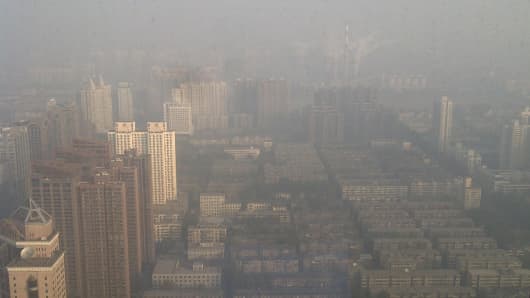The China Daily newspaper ran a story profiling the severity of air pollution Los Angeles and how it took 40 years of regulation and technology advances to bring it largely under control, as if to ask APEC visitors and locals alike for patience. But like many things that China does, it has the chance to fix their problems much faster-better-cheaper by learning from another California success story: the ports of Los Angeles and Long Beach.
Read MoreClimate-change deniers need to shut up and go away: Terry Tamminen
Fifteen years ago, a resident living near those ports testified at a hearing on air pollution by conducting a simple experiment. She cleaned her kitchen window ledge and wiped it with a white cloth to demonstrate it was free of any soot. An hour later, she wiped another white cloth over the ledge and it came away black. Holding up the two "before and after" rags, she and her neighbors spoke about higher rates of asthma, lung cancer, and other disease that experts confirmed were the result of toxins and fine particulate matter ("soot") emitted from port trucks, trains, ships and smokestacks. Imagine what the lungs of those residents and port area workers looked like.
Citizens sued; regulators got involved; legislators pushed policies and programs to solve the problem. Collectively, they agreed on a program that has cut air pollution by more than 80 percent since then. Simple measures yielded results almost immediately, including covering open storage of coal/coke and other bulk materials; prohibiting excess idling of trucks; and slowing ship speeds as they approached the ports. But major fixes needed an investment in cleaner trucks, electrification of docks (so ships could turn off diesel generators), direct rail service for containers to cut truck traffic, and other infrastructure improvements to move freight faster and more efficiently. Where to find the money for all of that?
Read More10 countries that may be hit hard by climate change
The ports imposed a fee of $35 (growing to as much a $200 over time) on each shipping container that came into the ports. Considering the value of goods in each container, the cost was a fraction of a penny per t-shirt or a few pennies on a flat screen TV, bicycle, BBQ or any of the thousands of other products imported through the ports. But collectively, on more than fourteen million containers a year, the fund grew enough to make all of those improvements very quickly and slash air pollution (and greenhouse gases that come out of the same sources) by more than 80 percent in five years. Residents cheered and virtually no one noticed the added cost.
So the lesson for China? A similar fee charged on the 150 million containers passing through its ports could quickly raise a massive investment fund. Like the ports, a combination of regulation and investment could quickly tackle the problem. Regulators could finally impose strict conditions on factories and power plants that cause the greatest pollution, but make grants and low interest loans to make it economically feasible to install scrubbers, convert to cleaner fuels, implement energy efficiency programs, and other measures that would quickly show the same results that the California ports realized. The investment would also stimulate employment and innovation, which are two things Chinese leaders also covet to maintain economic growth rates and social "harmony."
Read MoreIs climate change key to the spread of Ebola?
The APEC Summit, which was designed by China to showcase their growing pride and strength, also promoted free trade around the Pacific. If China seizes the opportunity to learn from the ports on the other side of their most valuable trade route, they can boost their economy, improve public health, and help to solve the world's most pressing environmental issues all at once — achievements well worth bragging about on the global stage in the future.
Commentary by Terry Tamminen, former secretary of the California Environmental Protection Agency. He is also the president of Seventh Generation Advisors and co-founder of the R20 Regions of Climate Action. Follow him on Twitter @terrytamminen.


